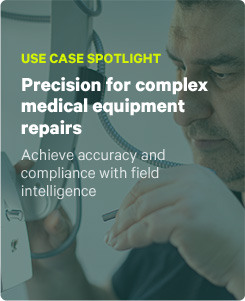External partners and their role in the future of field service
Picture this. You have an asset-intensive enterprise with manufacturing and service as crucial revenue generators. Maybe, in this scenario, you’re an HVAC manufacturer. You understand your products’ critical role in keeping homes and businesses comfortable. You have built and are responsible for an exceptional in-house team in your primary service area, with a solid customer base and a reputation for service. But see, heating and cooling needs are universal, so you acknowledge that your equipment is sold in areas far beyond your home base. And these assets also need to be serviced.
The Plan: Scale third-party technicians to work as your own
To expand your reach, you’ve teamed up with nearby third-party providers to handle maintenance and repairs in territories where you can’t be for several reasons. However, this decision has presented obstacles affecting both your revenue streams and customer satisfaction, factors that were not apparent when you made the call.
The first warning sign is a reduction in service income, with fewer maintenance contracts and renewals. Upon closer inspection, it’s clear that you don’t have the same asset visibility in locations where outside vendors are present. This lack of insight has caused you to shift from proactive to reactive service. You can’t proactively maintain a piece of equipment you have no data on. Adding to the problem, frequent customer feedback has declined, with many switching to competitors.
What could be causing these problems? You set to investigate.
The Underlying Issue: The reality of enlisting third-party service
When you turn your attention to the service technicians, you discover a data disconnect. Third-party technicians need access to your proprietary HVAC service records, maintenance protocols, and best practices. This information gap limits their ability to maintain the high service quality your customers expect. That disparity then leads to lower satisfaction, as you are not in control of the skill sets of technicians you don’t directly employ. From the customer’s perspective, they don’t know who to blame, just that something or someone must be at fault.
Is it the asset or the technician? If a large-scale industrial chiller is not getting the preventive maintenance it needs, it’s unfair to blame it on the equipment. Still, service organizations can’t expect customers to understand PM schedules and processes thoroughly. They just know something is not working right. And when the hardware gets in hot water, it becomes a lot easier for the customer to look for something else that works. Business interests external to yours may also come into play in this switch.
The HVAC Roadmap: Harnessing Technology for Unified Service
To rebuild your customer relationships, you need a foundation of unified service. The disconnect could be bridged by addressing the data collection disparity between your organization and third-party service providers. One avenue that you could explore is technology.
Centralized Platforms and Data Collection
Centralizing platforms and standardizing data collection methods ensures that all technicians – in-house or otherwise – can access the same crucial information. This uniformity enables proactive and consistent service delivery.
Workflows that can keep pace with complexity
By adopting an advanced technology platform, you can better handle complex work allocation and performance tracking. Also, you can build compliance into every workflow and ensure you and your service partners deploy the right skills for the right job, maintaining service quality.
Reinvigorated Customer Relationships
While you can’t neutralize the interests of third-party vendors that may sometimes compete with your own, technology can help you establish the same direct line of communication you have with customers in your primary service area. When combined with your field service management system, integrated CRM systems allow you to maintain regular touchpoints, collect valuable feedback, and monitor customer satisfaction metrics closely.
The Horizon: Enhanced Customer Lifetime Value
By synchronizing the customer, your technicians, and third-party service providers, you begin to see tangible benefits. You regain enhanced visibility into asset health and maintenance schedules, allowing for more informed customer interactions. This leads to decreased customer attrition rates and an increase in overall lifetime value. Your service quality becomes a unique selling proposition in these areas, attracting new customers impressed by your efficient and high-quality service delivery.
In a field service landscape that is ever-growing in size and complexity, there is pressure to deliver more revenue, cover bigger markets, and ensure service quality is constant. Third-party service is and will remain a necessity for the foreseeable future. However, with the right approach to technology, you can turn these market realities into opportunities and ensure your customers always feel they receive service directly from you, regardless of who performs it.




